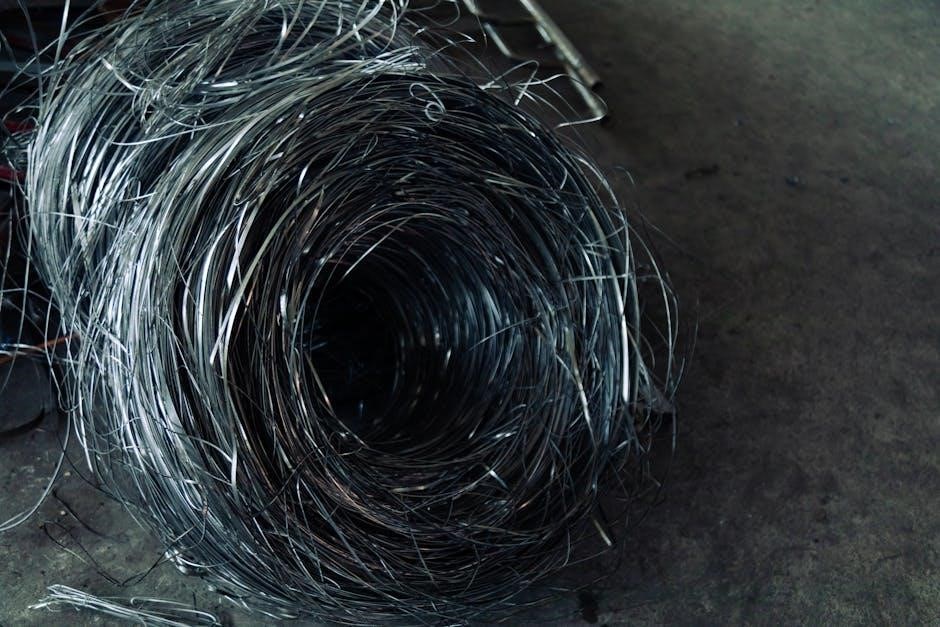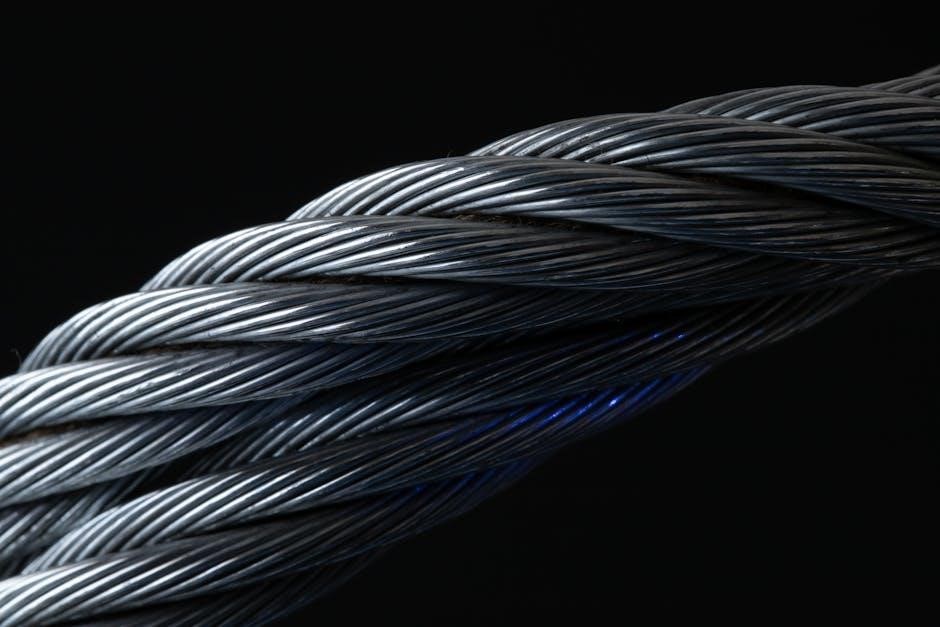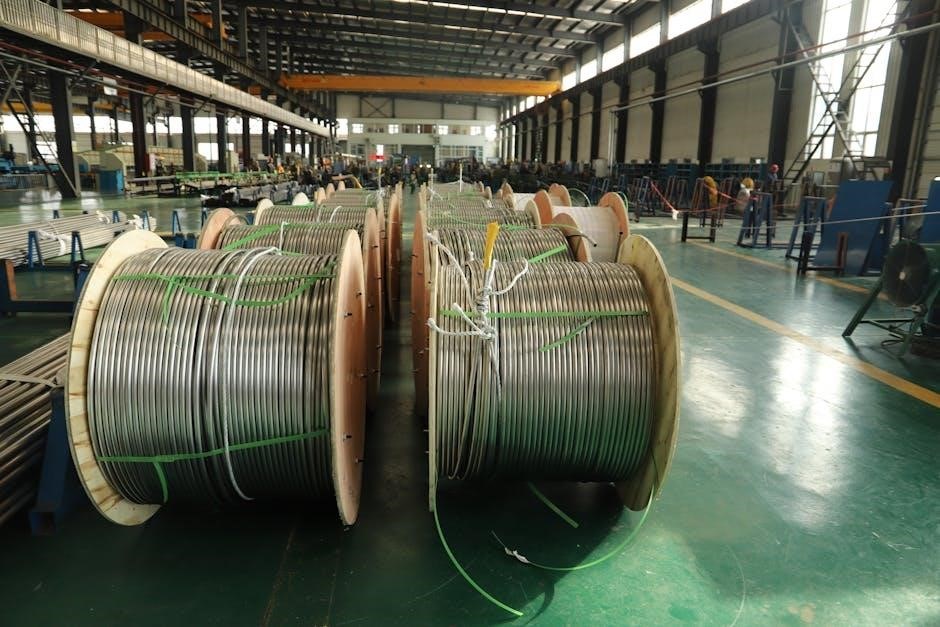The 1966 Chevelle ignition system is a critical component, ensuring proper engine operation. It includes the ignition coil, distributor, and wiring, designed to generate and distribute spark efficiently.
Overview of the 1966 Chevelle Electrical System
The 1966 Chevelle electrical system is a complex network designed to power all vehicle functions, including the ignition, lighting, and accessories. It features a combination of fuses and circuit breakers to protect against overloads. The wiring harness is color-coded, with specific hues like pink for 12V ignition power, ensuring proper connections. This system integrates components like the ignition coil, distributor, and alternator, with capacitors often installed to reduce interference. Understanding the electrical layout is essential for troubleshooting issues like no-spark conditions or faulty wiring. Regular maintenance, such as checking grounds and connections, is crucial for reliable operation.

Understanding the Ignition Coil Wiring Diagram
The ignition coil wiring diagram is essential for understanding the electrical connections. It illustrates the flow of power from the battery to the ignition coil and distributor.
Key Components of the Ignition Coil Circuit
The ignition coil circuit in the 1966 Chevelle consists of several vital parts. The ignition coil transforms low voltage into high voltage for spark generation. The distributor directs this voltage to the correct cylinder. The wiring harness connects these components, ensuring proper signal flow. Additionally, the ballast resistor regulates voltage to the coil, preventing overheating. The ignition switch activates the circuit, while spark plug wires carry the spark to the plugs. Each component must function correctly for reliable engine operation. Proper installation and maintenance are crucial to avoid issues like misfires or no-spark conditions. Understanding these parts is essential for troubleshooting and repairs.
Color Coding of the Wiring Harness
The wiring harness of the 1966 Chevelle uses specific color codes to identify circuits. The pink wire is designated for the 12V ignition power, essential for the ignition coil and distributor operation. A black wire typically serves as a ground or return path, while white wires often connect to switches or sensors. The yellow wire may be used for charging system functions, such as the alternator. These color codes help technicians trace and repair circuits efficiently. However, it’s important to verify against a wiring diagram, as modifications or aftermarket systems may alter standard color assignments. Proper identification ensures accurate diagnostics and prevents electrical system damage.
Identifying the Ignition Coil Connector
The ignition coil connector in the 1966 Chevelle is a vital component, typically located near the distributor. It consists of two terminals: one for the spark plug wire and another for the ignition circuit. The positive terminal is usually marked with a “+” sign, while the negative terminal connects to the wiring harness. The pink wire provides the 12V ignition power, and a black or white wire may serve as the ground. Always refer to the wiring diagram to confirm connections, as incorrect wiring can cause ignition failure or damage. Proper identification ensures the coil operates efficiently, delivering the necessary spark to the engine.
Step-by-Step Guide to Wiring the Ignition Coil
The 1966 Chevelle ignition coil wiring involves connecting the pink 12V ignition wire to the positive terminal and the black/white wire to the negative terminal, ensuring proper spark generation.
Locating the Ignition Coil and Associated Wires
The ignition coil on a 1966 Chevelle is typically mounted on the driver’s side fender well. To locate it, trace the pink 12V ignition wire from the distributor cap. The coil is connected to the distributor via a black/white wire, which carries the spark signal. Additionally, a pink wire provides constant 12V power, while a black wire serves as the ground connection. Ensure the capacitor is installed near the coil to suppress radio interference. Always consult the wiring diagram PDF to verify wire colors and connections, as modifications may vary. Proper routing and grounding are essential for reliable ignition performance.
Connecting the Ignition Coil to the Distributor
To connect the ignition coil to the distributor on a 1966 Chevelle, start by identifying the pink 12V ignition wire and the black/white wire. The black/white wire from the distributor connects to the ignition coil’s terminal. Next, attach the pink wire to the coil’s positive terminal, ensuring it provides constant 12V power. Secure all connections tightly to avoid spark loss. If using an HEI distributor, the pink wire should be routed directly to the coil. Always refer to the wiring diagram PDF for accurate connections. Proper installation ensures reliable spark delivery and engine performance. Trimming excess wire and securing connections are crucial for durability and safety.
Routing the Pink 12V Ignition Wire
The pink 12V ignition wire is critical for powering the ignition system. Route it from the ignition switch to the ignition coil, ensuring it is isolated from high-heat sources like the exhaust. Use wire looms or tape to protect it from abrasion and moisture. If installing an HEI distributor, connect the pink wire directly to the coil terminal. Avoid routing near moving parts or electrical interference sources. Trim excess wire to maintain a clean setup. Secure connections firmly to prevent voltage drops. Refer to the wiring diagram PDF for precise routing paths. Proper installation ensures reliable 12V power delivery to the ignition system.

Troubleshooting Common Ignition Issues
Common ignition issues include no-spark conditions, misfires, or intermittent starting problems. Check the ignition coil, distributor cap, and spark plug wires for wear or damage.
Diagnosing No-Spark Conditions
A no-spark condition in the 1966 Chevelle can be traced to issues in the ignition system. Start by checking the pink 12V ignition wire connected to the coil, ensuring it has power when the ignition is on. Verify the ignition coil’s resistance using an ohmmeter to ensure it matches the manufacturer’s specifications. Inspect the distributor cap and spark plug wires for cracks or wear. If using an HEI distributor, ensure it is properly connected and grounded. Check the circuit breakers and fuses, as they may protect the ignition circuit. Finally, test the spark by grounding the spark plug wire; a strong spark indicates the system is functioning correctly.

Testing the Ignition Coil Resistance
Testing the ignition coil resistance is essential to ensure proper spark generation. Use an ohmmeter to measure the primary and secondary windings. Connect the ohmmeter leads to the coil’s terminals, ensuring correct polarity. The primary winding typically reads between 0.5 to 3 ohms, while the secondary winding should range from 5,000 to 15,000 ohms. If the readings are out of spec, the coil may need replacement. Always refer to the wiring diagram or manufacturer’s specifications for accurate values. This test helps identify faulty coils, ensuring reliable ignition system performance in your 1966 Chevelle.
Reading the 1966 Chevelle Wiring Diagram PDF
The 1966 Chevelle wiring diagram PDF provides a detailed visual guide for understanding the vehicle’s electrical system. It includes schematic symbols, wire colors, and component locations, ensuring accurate repairs and modifications. Use it to identify circuits, trace wiring issues, and verify connections for components like the ignition coil. This resource is essential for maintaining or upgrading your Chevelle’s electrical system.
Interpreting the Schematic Symbols
Understanding the schematic symbols in the 1966 Chevelle wiring diagram is crucial for accurate repairs. Symbols represent components like the ignition coil, distributor, and fuses. Color-coded lines indicate wire connections, while abbreviations denote functions. For example, “IGN” refers to ignition components, and “12V” marks power sources. These symbols guide technicians in tracing circuits, diagnosing faults, and ensuring proper wiring. By interpreting these symbols, enthusiasts can confidently modify or repair their Chevelle’s electrical system, avoiding costly mistakes. The diagram’s legend explains each symbol, making it easier to decode and apply the information effectively.
Identifying Circuit Breakers and Fuses
The 1966 Chevelle uses a combination of circuit breakers and fuses to protect its electrical systems. Circuit breakers are often used for high-current circuits like headlamps and power windows, eliminating the need for fuses in these areas. Fuses, however, are still present in the main fuse box to protect lower-current circuits. The wiring diagram helps locate these components, with circuit breakers typically found in the main electrical panel or under the dash. Fuses are usually color-coded and labeled, making them easier to identify. Understanding these components is essential for troubleshooting electrical issues and ensuring proper system function. Always refer to the diagram to pinpoint the correct breaker or fuse for specific circuits.

Upgrading to a Modern Ignition System
Upgrading the 1966 Chevelle ignition system enhances performance and reliability. Modern systems, like HEI distributors, offer improved spark output and easier installation. This upgrade ensures better engine efficiency and reduced maintenance;
Installing an HEI Distributor
Installing an HEI (High Energy Ignition) distributor in your 1966 Chevelle is a popular upgrade for improved spark output and reliability. Begin by disconnecting the battery to ensure safety. Remove the old distributor cap and rotor, taking note of the spark plug wire locations. Next, install the HEI distributor, aligning the rotor with the ignition timing mark. Connect the pink 12V ignition wire to the HEI coil terminal, as specified in the wiring diagram. Reattach the spark plug wires to the new cap, ensuring proper routing. Finally, reconnect the battery and test the ignition system for proper function. This upgrade enhances performance and reduces maintenance.
Relocating the Ignition Coil for Better Performance
Relocating the ignition coil in your 1966 Chevelle can improve performance by reducing electromagnetic interference and heat exposure; Choose a location away from the ECU and high-heat components. Secure the coil using a sturdy bracket to prevent vibration. Route the wiring harness neatly, ensuring the pink 12V ignition wire is connected directly to the coil. Properly ground the coil to maintain consistent spark output. This relocation enhances reliability and reduces the risk of misfires. Always consult the wiring diagram to avoid circuit conflicts and test the system after installation to ensure functionality. This modification is a simple yet effective way to optimize ignition performance.
